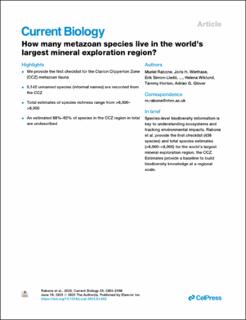| dc.contributor.author | Rabone, Muriel | |
| dc.contributor.author | Wiethase, Joris H. | |
| dc.contributor.author | Simon-Lledo, Erik | |
| dc.contributor.author | Emery, Aidan M. | |
| dc.contributor.author | Jones, Daniel O.B. | |
| dc.contributor.author | Dahlgren, Thomas Gunnar | |
| dc.contributor.author | Bribiesca-Contreras, Guadalupe | |
| dc.contributor.author | Wiklund, Helena | |
| dc.contributor.author | Horton, Tammy | |
| dc.contributor.author | Glover, Adrian G. | |
| dc.date.accessioned | 2023-08-17T10:26:39Z | |
| dc.date.available | 2023-08-17T10:26:39Z | |
| dc.date.created | 2023-06-14T15:30:46Z | |
| dc.date.issued | 2023 | |
| dc.identifier.citation | Current Biology. 2023, 33 (12), 2383-2396. | en_US |
| dc.identifier.issn | 0960-9822 | |
| dc.identifier.uri | https://hdl.handle.net/11250/3084545 | |
| dc.description.abstract | The global surge in demand for metals such as cobalt and nickel has created unprecedented interest in deep-sea habitats with mineral resources. The largest area of activity is a 6 million km2 region known as the Clarion-Clipperton Zone (CCZ) in the central and eastern Pacific, regulated by the International Seabed Authority (ISA). Baseline biodiversity knowledge of the region is crucial to effective management of environmental impact from potential deep-sea mining activities, but until recently this has been almost completely lacking. The rapid growth in taxonomic outputs and data availability for the region over the last decade has allowed us to conduct the first comprehensive synthesis of CCZ benthic metazoan biodiversity for all faunal size classes. Here we present the CCZ Checklist, a biodiversity inventory of benthic metazoa vital to future assessments of environmental impacts. An estimated 92% of species identified from the CCZ are new to science (436 named species from a total of 5,578 recorded). This is likely to be an overestimate owing to synonyms in the data but is supported by analysis of recent taxonomic studies suggesting that 88% of species sampled in the region are undescribed. Species richness estimators place total CCZ metazoan benthic diversity at 6,233 (+/−82 SE) species for Chao1, and 7,620 (+/−132 SE) species for Chao2, most likely representing lower bounds of diversity in the region. Although uncertainty in estimates is high, regional syntheses become increasingly possible as comparable datasets accumulate. These will be vital to understanding ecological processes and risks of biodiversity loss. | en_US |
| dc.language.iso | eng | en_US |
| dc.rights | Navngivelse 4.0 Internasjonal | * |
| dc.rights.uri | http://creativecommons.org/licenses/by/4.0/deed.no | * |
| dc.title | How many metazoan species live in the world's largest mineral exploration region? | en_US |
| dc.title.alternative | How many metazoan species live in the world's largest mineral exploration region? | en_US |
| dc.type | Peer reviewed | en_US |
| dc.type | Journal article | en_US |
| dc.rights.holder | 2023 The Author(s) | en_US |
| dc.description.version | publishedVersion | en_US |
| cristin.ispublished | true | |
| cristin.fulltext | original | |
| cristin.qualitycode | 2 | |
| dc.identifier.doi | 10.1016/j.cub.2023.04.052 | |
| dc.identifier.cristin | 2154558 | |
| dc.source.journal | Current Biology | en_US |
| dc.source.volume | 33 | en_US |
| dc.source.issue | 12 | en_US |
| dc.source.pagenumber | 2383-2396 | en_US |

